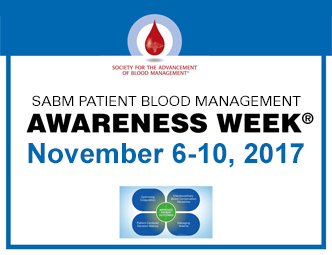SUMMER 2017
ISSUE

The Society for the Advancement of Blood Management (SABM)
invites healthcare organizations worldwide to participate in this week dedicated to educating patients and healthcare professionals about patient blood management.
Download SABM's
Patient Blood Management Awareness Week 2017
Poster and Timeline
Please consider making a donation to your Society. Your donations will help us to improve the lives of people throughout the world through Patient Blood Management.

SABM 2017 Newsletter Publication Schedule
February | May | August | November
Editor
Carolyn Burns, MD
Associate Editor
Tiffany Hall, RN
Contributors
Carolyn Burns, MD
Nabil Hassan, MD
Tiffany Hall, RN
Mary Ann O’Brien RN, MSN, CCRN, CNE
Becky Rock, RN
Kevin Wright
Zac Zahara, MBA and team
Transition Director
Sherri Ozawa, RN
SABM Officers and
Directors
|
|
SABM Spotlight
Patient Blood Management as Standard of Care
Aryeh Shander, MD; Arthur W. Bracey, Jr., MD; et al. Anesthesia & Analgesia 123(4):1051-1053, October 2016
SABM was born of the idea that, to improve the care of patients who potentially required transfusions, it was necessary to increase collaboration between transfusion medicine specialists and the clinical team. SABM founders understood that, to ably treat any hematologic conditions, with or without blood products, one would need to understand the role of blood elements in maintaining health.
Today, sixteen years later, SABM remains in a unique position as a professional organization committed to education, research, and best practice recommendations to advance PBM as the standard of care. As an organization, SABM focuses on the safety of the patient and their clinical outcomes rather than on the safety of a therapy. SABM properly moves care away from a blood product–oriented treatment aimed at correcting a specific deficit, toward comprehensive management of an anemic patient (or one at risk for anemia) utilizing a variety of resources. In an era of a rapidly evolving value-added heath care environment, improved patient outcome takes center stage. PBM seems to fulfill that goal, and many scientific circles have embraced it.
Pediatric Anemia: It Is in the Eye of the Beholder
Nabil Hassan, MD Anesthesia & Analgesia 123(6):1354-1355, December 2016
In this issue of Anesthesia & Analgesia, Dr. Hassan provides an editorial on Dr. Faraoni's and colleagues' work ("Relationship Between Preoperative Anemia and In-Hospital Mortality in Children Undergoing Noncardiac Surgery” Faraoni, et el., Anesthesia & Analgesia December 2016 - Volume 123 - Issue 6 - p 1354-1355). This study demonstrated that age-based preoperative low blood hematocrit levels were associated with greater postoperative in-hospital mortality. This is a rare investigation in the pediatric surgical population that has not been addressed previously on such a large scale. While the authors used a definition of anemia that is derived from the age-related normative values, many clinicians would not consider this as an alarming hemoglobin level physiologically.
It has been demonstrated that increasing hemoglobin level with blood transfusions was associated with worse outcomes in the neonates, trauma, and pediatric critical care patients. There is a need to examine whether the use of hematopoietic agents and hematinics is safer than red blood cell transfusions in increasing hemoglobin and altering the postoperative outcomes. This work’s revelation of anemia and mortality risk association may make the case for a more rigorous preoperative patient evaluation for anemia. It lays the foundation for future interventional investigations, but for now, one size does not fit all and anemia is largely in the eye of the beholder.
Implementation of Massive Transfusion Protocols in the United States: The Relationship Between Evidence and Practice
Ronald Chang, MD and John B. Holcomb, MD Anesthesia & Analgesia 124(1):9-11, January 2017
In their article “Massive Transfusion Protocols: A Survey of Academic Medical Centers in the United States” Treml and colleagues performed a web-based survey of massive transfusion protocol (MTP) implementation at blood banks across the United States. The authors report that the blood banks included in their study were relatively uniform in the MTP goal (plasma:RBC ratio) with 70% of respondents aiming for a 1:1 ratio. The authors state that there is a lack of published guidelines regarding composition of MTPs. However, the Committee on Trauma of the ACS has published guidelines on massive transfusion in trauma as part of the Trauma Quality Improvement Program. The authors also highlight the glaring disconnect between evidence and practice, especially with regard to massive transfusion of nontraumatic hemorrhage. This should serve as a call to investigators in this field to narrow this knowledge gap to optimize patient care.
Contributor: Kevin T. Wright
|
|
PBM for Patient Blood Management Section

Save the Date for SABM's Annual Meeting
September 7 – 9, 2017
Hilton & Executive Tower
Portland, Oregon
PBM Certificate Course
September 6, 2017
7:00am – 6:00pm
Annual Meeting
September 7 – 9, 2017

Consider submitting your future manuscripts in PBM for peer review and publication in this new section. The success of this endeavor will depend on the provision of material to make it lively and attractive to our colleagues and other professionals in the field.
Members Invited to Submit Papers CLICK HERE
Join SABM's Call to Action for Medicare to Expand Coverage for Treatment of Anemia!
Click HERE for detailed information about what you can do to get involved.
© 2017 Society for the Advancement of Blood Management
350 Engle Street
Englewood, NJ 07631
Phone: (928) 551-6400
Fax: (877) 944-2272
EMAIL: [email protected]
|